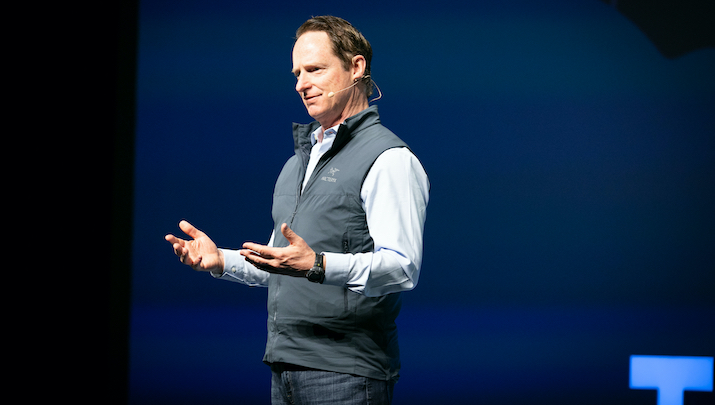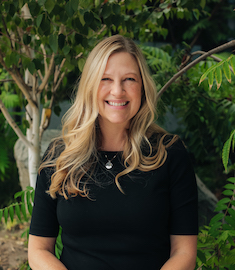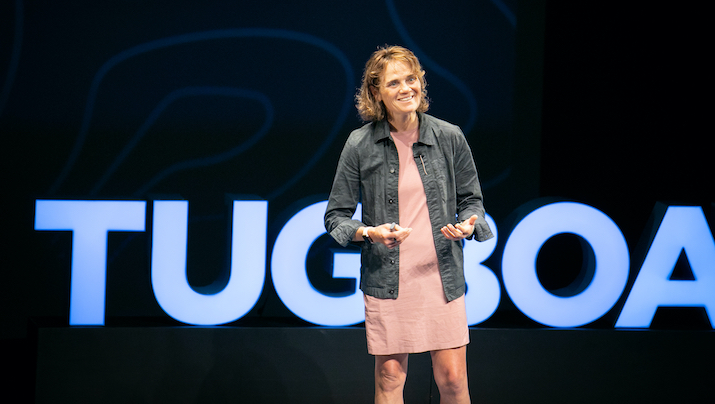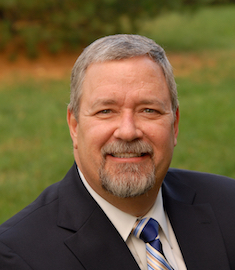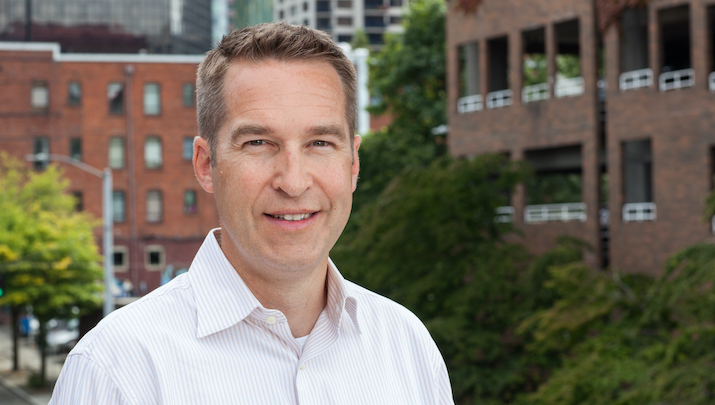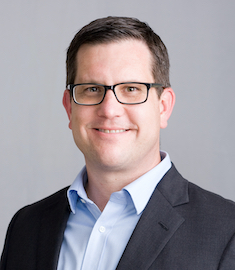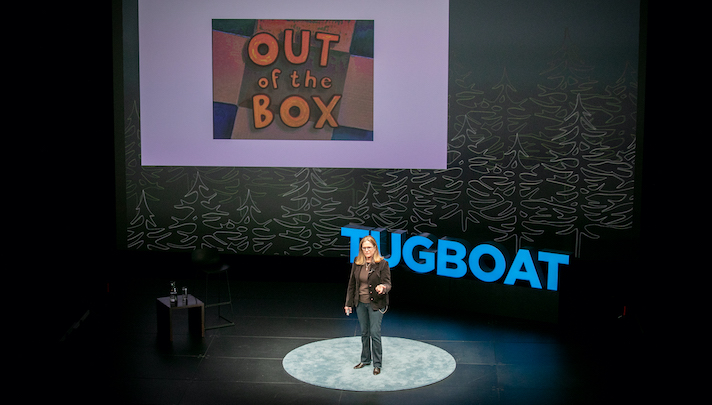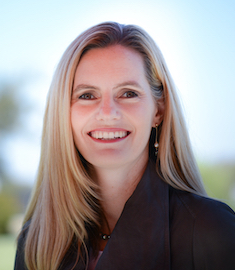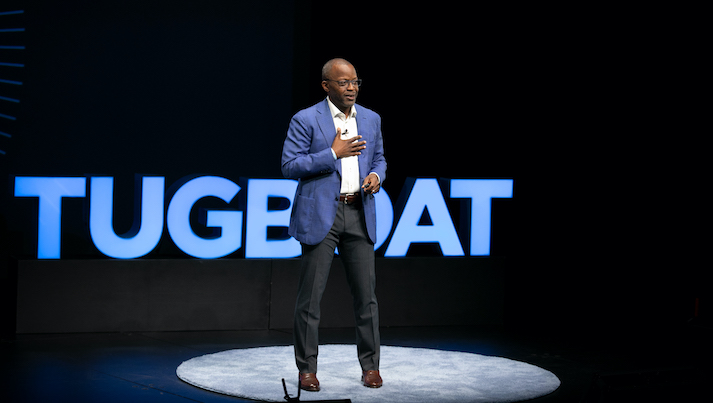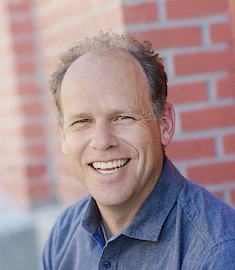The Moment Of Divergence
When Tugboat Institute® CEO Dave Whorton began his career at Kleiner Perkins, he was presented a “playbook”—a guide that defined early venture capital (VC) investment as a strategy focused on profitability and sustained growth. In 1995, with the historic public offering of Netscape, that playbook was thrown out and VC entered a new era. Get big fast.
In this talk from Tugboat Institute Summit 2021, Dave shares his personal experience of witnessing that “moment of divergence” and how that seismic shift in VC investment shaped the way companies are built, scaled, financed and exited along with how that deviation impacted CEOs, employees, customers, suppliers and communities. Dave also describes how private Evergreen® companies offer leaders, teams, and society an alternative model of doing business—one that recognizes the role of business as a force for good.
In Praise Of Self-funded, Paced, Intentional Growth
When my husband, Oliver, and I launched our Evergreen® business, Icicle Brewing, we were well aware of the risk involved in a capital-intensive business. Oliver is fifth generation in a farming family in the Yakima Valley in Washington state, and he had been raised through repeated, necessary cycles of bank loans and equipment expenses and the continual underlying stress of unpredictable events that shape life and finances on a farm.
But he also understood the long-term view and growth mindset that is essential for farming and for Evergreen business. He had observed the expansion and evolution of his family’s farm from hops to include apples and cherries, had raised his own cattle in college, and he always had an entrepreneurial vision to build something of his own.
When Oliver and I married after college and moved to the family farm, I was immersed in those same cycles. After several years on the farm, we made the decision to branch out on our own, investing in land and developing a vineyard—another capital-intensive enterprise.
In fact, it was our investment in the vineyard, which we funded ourselves, that left us cash poor and led us to take the first small step toward what would become München Haus and Icicle Brewing. With three young children at the time and the vineyard still in early stages of growth, we needed cash to pay our bills. We decided to open a small kettle-corn stand on one of two investment properties we had purchased in Leavenworth, Washington, a Bavarian-themed resort town in the Cascade mountains. While Oliver continued to work the vineyard, we brought our kids to Leavenworth each weekend, where I popped and sold kettle corn to generate a bit of income.
While the stand, München Haus, became popular, it wasn’t generating enough revenue to justify commuting indefinitely. In the spring of 2002 we made the decision to sell the vineyard and move our family to Leavenworth, using the profit from the sale of the vineyard to fund an expansion of München Haus to include a sausage grill and craft-focused beer garden .
As we put down roots and steadily grew our small business as we generated the profit to do so—literally one piece of equipment and one incremental improvement at a time—our Purpose became clear. We wanted our business to provide benefit for the community, to create a place for people to gather and connect, and to create jobs.
Those goals were the motivation behind each significant stage of our growth. In 2009, we secured a bank loan—a two-year-long endeavor in the wake of the Great Recession—to build a brewery and taproom on our second lot in Leavenworth. We had traveled in Germany with our family and had seen the role of breweries as community hubs in small towns, and we wanted to expand on our existing presence to offer that to our community. We knew that, in addition to investing in the facility and equipment to brew beer, we would need to hire a master brewer to bring that dream to life, which we did. With those early self-funded capital expenses, Icicle Brewing was born.
As visitors and locals came to love our beer and spread the word, increased demand led us to sign on with a distributor, which shrunk our margins but broadened our reach, and ultimately led us to outgrow our original facility. In 2017, we were bursting at the seams in our downtown brewery, and we made the decision to purchase a new property and expand again. We built a production facility and purchased a packaging system, which were our biggest capital investments to date. We funded that expansion through financing that included taking a mortgage out on our family home, which we recognized was a very personal risk but felt was a calculated step, justified by demand.
With an eye on innovation and customer experience, we purchased an experimental brewhouse and remodeled our taproom at the downtown location at the same time. That investment in production, packaging, and innovation proved invaluable through the COVID-19 pandemic. When retail shut down, we were able to shift our focus to packaging, marketing, and distribution efforts, as well as developing new experimental beers.
In 2021, we’re celebrating the ten-year anniversary of Icicle Brewing and the 20-year anniversary of München Haus, which provides an opportunity to reflect on our Paced Growth over time. Each stage of our growth has required that we evaluate and reaffirm our commitment to growing a private business through our own profits. Our journey has been a constant balancing act between funding improvements and capital expenses to keep us growing and relevant while also maintaining profitability, which has allowed us to take care of our people and protect our business. Throughout, we have been steadied by our desire to grow within our means and base that growth on increasing demand.
We’ve taken a series of financial risks to respond to the demand, but we’ve always understood that taking those calculated steps to grow leads to long-term sustainability. Our paced, intentional growth has meant we didn’t need to take on outside investment, and though we’ve been approached by interested buyers, we’ve never seriously considered selling. We love what we do and we want to continue to grow the business with our team.
As we expanded, we have also evolved the organizational structure by building a leadership team and a board of directors and to engage in a more formalized growth strategy and planning process. We know these governance structures and planning processes will further improve our company’s long-term prospects to the benefit of our people and to the communities we serve.
Through that planning process, we made a decision in 2018 to gift a portion of our ownership to key employees to strengthen and incentivize our management team. Oliver and I also transitioned out of daily operational roles to assume advisory positions in the company—Oliver is Chair of the Board and I lead culture and employee professional development efforts. That change allows us to continue to steward the business while empowering our team to innovate and to lead our long-term success. We see endless possibilities for the company and the team, and we look forward to seeing where and how the business will continue to grow.
Pamela Brulotte is Co-founder and owner, with her husband Oliver, of Icicle Brewing Company and München Haus.
The Future Of Work And Workplace
How and where we work has changed in the wake of the pandemic, and questions related to the future of workspace continue to rise to the surface. How will leaders and companies adapt and evolve to meet employees changing needs and expectations? What are the key steps in a “return-to-work” strategy? How will shifting and expanding roles impact the workplace? What are the key components of effective workspace design that nurture collaboration and creativity?
Lisa Picard, President and CEO at EQ Office, a commercial real estate company that designs spaces to maximize human potential, has a unique perspective into these questions. In this talk from Tugboat Institute Summit 2021, Lisa shares her experience with this dynamic topic that continues to create challenges and opportunities for employers and employees.
Why Franchising Is "Truly An American Gem"
I entered into college with what I thought was a clear career path. I was surrounded by friends and family who had pretty serious professional plans—to be doctors and lawyers and geologists—and I followed suit, with my eye on mechanical engineering. But when my Pop died in my first year, I found myself, at age 19, at a crossroads. My world was unraveling, and I no longer knew what I wanted to do with my life.
That juncture proved pivotal for me because it forced me to think about what I really wanted to study and how I wanted to make my way in the world. What I knew was that l loved team sports and the spirit of group efforts. I wanted to be part of something bigger, to take a different path.
I changed gears to pursue a degree in economics, focused on studying how teams and crews operate effectively—not just if they win, but how they win. That change in course would lead me toward what has now been a 40-year career leading franchise companies and helping individuals build highly productive and profitable teams that set industry standards.
My own experience in the franchise world began with my decision to sign on as a franchisee with College Pro Painters, an organization that put young students in charge of their friends to paint houses. I launched my franchise in Philadelphia in fall of 1982. My experience with College Pro showed me the power of a values-driven organization to provide an onramp for entrepreneurial leaders and help create economic opportunity for individuals and communities. I was hooked.
From that point, I stayed with College Pro for 10 years before co-founding CertaPro Painters (the full-time version of College Pro). From there, I went on to serve in a variety of roles for FirstService Brands, which is the parent of CertaPro. FirstService Brands owns a portfolio of franchises, including Paul Davis Restoration, CertaPro, FloorCoverings International, California Closets, and Pillar to Post Home Inspectors. Today, I serve as President and CEO of FirstService Brands, CEO of California Closets, and as 1st Vice Chair of the International Franchise Association.
My experience leading and growing franchise businesses around North America has led me to understand that franchising provides the most democratic distribution of wealth in the world. This model is truly an American gem. It offers a low-risk entry point for high performers to start and scale businesses, often with minimal initial capital investment, and with the benefit of systems and processes of established brands. I also believe that these businesses are uniquely aligned with the Evergreen 7Ps® principles, offering values-driven leaders a path to building Evergreen® companies to benefit families and communities.
To see the value proposition and opportunity in franchising, it’s first important to understand the model. A franchisor is the owner of a great idea—a brand, or a promise that’s delivered and measured. The franchisor develops and owns the intellectual property around that brand (the trademark and the methods of operation to train and support that idea to be duplicated in other locations). A franchisee enters into an agreement with the franchisor to implement that idea and the associated processes in a new location, benefitting from the centralized marketing and other systems, to execute in their communities. The franchisee pays the franchisor a set royalty (five percent, on average) and controls and makes decisions around the other 95 percent of the revenues. The key to success for the franchisee is to scale the business, generally through adding team members over time. While some franchises are more capital heavy (restaurants, for instance), others are capital light and can scale more quickly.
I see the overlap with Evergreen businesses clearly in the foundation of a shared value set, the characteristics of successful leaders across Evergreen companies and franchises, and in the impact of these business on individuals, families, and communities.
When I began with College Pro, I saw the impact of guiding values that inspired and connected franchisees and led to success for the business. The values were presented as an acronym, D-R-I-P, which stood for: Deliver what you promise; Respect the individual; Practice continuous Improvement; and Have Pride in your work. These were repeatedly emphasized so they would be instilled throughout the organization. When I went on to lead CertaPro, we understood the role of guiding values and also learned very early on that successful franchisees shared specific personal qualities. Over time, we created a screening tool to evaluate potential franchisees, based on their preferences, which we refer to with the mnemonic, A-T-L-I-P, which stands for: Attainment, Tenacity, Leadership, Introspection, and Precision. Across both businesses, those who became successful entrepreneurs in the franchise model operated from a shared value set and embodied these key qualities.
Many of the values and personal characteristics that lead to success for our franchisees reflect Evergreen 7Ps principles. While some of the crossover is clear—between Tenacity and Perseverance, People First and Respect, Pragmatic Innovation and continuous improvement, for instance—Paced Growth and Profit are also as essential in the franchise model as in Evergreen companies. A franchise is successful if it grows to a specific, optimal scale in a given industry and location—that’s what the model is built to do. When these businesses grow and become more profitable, they create more opportunity.
Creating opportunity is what my life’s work is about and what the franchise model does best. By providing the right person the chance to build a business within the guardrails of an established brand and practices, franchises de-risk the onramp to entrepreneurial success. Individuals can invest time and effort to scale a business within their community, providing more jobs as the business grows and keeping the majority of the earnings in the community as well. When it comes time for the franchisee to transition out of the business, he or she has the added benefit of selling an established brand, which generates a higher sale price, selling to employees, or passing the business down to a second generation within the family. In all three scenarios, the enterprise continues to thrive in the community and create more opportunity.
The benefit of franchises to fuel the economic engine of a community in this way is clear across industries and geographies. The franchise model serves 140 industries, with approximately 725,000+ franchisees operating today. More important, it can play a significant role in lifting up individuals and families in underserved communities. In locations where other businesses may not want to invest resources, a franchise can offer an entrepreneur the opportunity to assemble and deploy resources quickly to get a running start. And when these businesses are restaurants and healthcare services, which may not otherwise be launched in these areas, the positive impact can be transformative.
When I made the decision to step into franchising, I couldn’t have anticipated where it would take me. When one door closes, another opens. The early, unanticipated change in my life experience propelled me off the expected path and forced me to engage and act upon shared values, contribution, and community, and my career in franchising has allowed me stay focused on these pillars ever since.
Charlie Chase is IFA 1st Vice Chair of the International Franchise Association and President and CEO of FirstService Brands, Inc.
Driving A Culture Of Innovation
In this talk from Tugboat Institute Gathering of Teams 2021, Bart Ricketts, CEO of Lease Crutcher Lewis, a Pacific Northwest construction company, shares three organizational initiatives that drive innovation and create an environment in which employees feel supported, respected and heard. Learn how this 135-year-old company Evergreen® company is building towards its next 100 years in business.
Fostering Mentorship Provides The Greatest Dividends
When I was hired at Rincon Consultants as an entry-level scientist, I joined the firm hungry to learn and to make the most of my opportunity. When I landed and executed a big project early on, I caught the attention of one of the co-founders, then President and CEO of the firm, Mike Gialketsis. From that point, Mike became a mentor, and we developed a relationship that shaped my career trajectory and is reflected in my leadership of the company today.
In the beginning, if I’m being honest, I was overly confident. Mike saw my promise, but he also understood the need to challenge me. He made me question my decisions and my knowledge through a number of really uncomfortable conversations. During those early years of Mike’s mentorship, it was his commitment to my growth as a leader that led eventually to my role as CEO of the company.
Learning from someone who pressed me to question my assumptions and to approach things differently forced me into critical yet flexible thinking. Mike also gave me a lot of room to run, allowed me to make mistakes, and then helped me process and understand the lesson from each experience. Most of the time, he had a good laugh, too, which in the moment was infuriating but offered me welcome perspective over time: it’s not the end of the world to fail; it’s an opportunity to learn.
At the time I began my career at Rincon, the company employed roughly 50 people, and Mike took an active role in mentoring several of us. Today, every single person Mike mentored serves in a leadership role in the company. We have developed a deeply rewarding culture that values the lessons learned and not just the victories. Our firm now employs about 350 people in 13 offices, and mentorship remains a priority.
Our efforts have not been an unmitigated success. We had years of high turnover, when a sink-or-swim mentality led to attrition, and we didn’t yet have the programs and processes in place to help nurture retention. We’re still navigating the challenge of maintaining the culture of our founders as we implement operational structure to support our growth. In the last four or five years, as we have found our footing, we have been able to develop clearer guidance around career development and mentorship that supports our foundational spirit of informal connections, camaraderie, and generous guidance while providing a company-wide program for the benefit of all employees.
Today, career development and mentorship starts on a new employee’s first day. In my role as CEO, I onboard every new employee, from entry-level on up. My goal in those early interactions—part of a week-long process led by our Chief People Officer and other principals—is to describe the “Rincon Way,” to educate new hires in our culture and values, and to establish a common language and connection from the beginning. I want people to launch their path at Rincon with a firm foundation, understanding that we will support their career path—and that a key driver in their success will be developing meaningful relationships within the company.
Another key aim of those sessions is to break traditional perceptions of strict leadership hierarchy by setting the precedent of open access to our leadership team and myself for ongoing mentorship. I explicitly tell new employees that my calendar is open, and they are welcome to book an appointment any time. And yes, that means I spend a lot of time talking with folks. But I believe that time spent nurturing relationships and fostering mentorship provides the greatest dividends. If we want to grow leaders from within and give people confidence that they have a long-term future and a path to advancement at Rincon, our leaders need to show up.
In addition to my role in onboarding, I mentor about eight team members on a reoccurring basis. The goal of these mentorships is two-fold: to provide guidance in specific aspects of a person’s role that might need attention to allow him or her to progress to the next level of leadership and to coach high-potential team members, the rising stars who will lead our next generation. In both cases, my intention is to develop trusted relationships over time that will allow for productive coaching and leadership development. I realized long ago that to be able to send a message and have it understood, or better, not misunderstood, you need to surround yourself by people who trust that you are genuine, and you cannot fake genuine.
Alongside my individual role as a mentor, we have developed a company-wide program to support informal and formal mentorship relationships. Often, given the culture of connection at the company, these relationships still unfold organically. When that happens, we encourage mentors and mentees to notify HR of these relationships and to provide regular updates so we can support the connections. If an employee is seeking a mentor and has not connected with someone informally, the HR department and the employee’s supervisor will work together to align the employee’s goals with the appropriate mentor. All employees are eligible to request mentorship, but participation is voluntary.
To further encourage wide participation, our Professional Development Committee has also created an intranet channel devoted to mentorship, through which we provide regular resources and program updates, as well as data around benefits of mentorship. We’re a group of scientists, after all, and I’ve found that our team likes to analyze everything from a data standpoint to understand if it has value. When we can provide study results and research around mentoring, we get better buy-in across the board.
In addition to encouraging broad mentorship—formally and informally—and supporting those who engage, we take intentional steps to identify and support rising stars in their career path planning. When we see significant leadership promise in an employee, we create additional points of exposure to business management and leadership experience. One of the key experiences is an invitation to an employee to serve on a committee within the company. This engagement provides welcome insights into the business, and, more important, these committees serve as fertile ground for developing mentee/mentor relationships between rising stars and key executives across the organization.
As a growing company, the process of developing a formalized mentorship program is ongoing. But I think that the culture of mentorship that shaped my career trajectory and that of so many other key leaders here will continue to serve us well. Ultimately, my goal in all the efforts around mentoring at Rincon is to develop more leaders grounded in trusted relationships to drive the company forward.
I feel the responsibility of carrying the water, of continuing to nurture the culture of mentorship that guided my path and which I think is the key to propelling our continued growth. As we continue to grow and evolve, I know that our success in that effort and all we do will not be dependent on any one individual but on the shared, long-term vision of our current and future team.
John Dreher is President and CEO of Rincon Consultants, Inc.
Storytelling & Excellence
As a film producer and President of Flashlight Films, Allyn Stewart, has mastered the process of developing compelling stories and translating them into captivating films. In this talk from Tugboat Institute Gathering of Teams 2021, Allyn shares her journey through Hollywood and her philosophy that true excellence in storytelling comes from the creator’s unwavering commitment and unshakable belief in the story they want to tell. According to Allyn, story is EVERYTHING–whether it’s a movie, a product or a service.
How This Century-Old Family Business is Preparing for the Next Generation’s Leadership
Our family began farming in Lodi, California the late 1800s, when my great-great grandparents emigrated from Germany and began growing non-irrigated watermelons. From that humble beginning, the family grew their holdings and ultimately bought a vineyard in 1916. Each generation since has built on the efforts of the one that came before, continuing the legacy of stewardship of the land.
Our business, LangeTwins Family Winery and Vineyards, grew from that foundation, a partnership between my father and his twin brother, who bought land from their parents and launched their own viticultural company at the ripe old age of 25.
So, I’m a fifth-generation member of our farm family, but a second-generation operator in LangeTwins Family Winery and Vineyards. I’m the first of our three, but, really, the eldest of five. Let me explain. I have two brothers and two cousins on my uncle's side, and we were raised as a family of nine. Two sets of parents, five kids, living next door to one another in houses built 100 yards apart, in the middle of 200 acres of land without a neighbor to be seen.
Suffice it to say, my brothers and my cousins were my playmates and closest confidants as we grew up together—literally in the middle of our family business. Our bond began in the sandbox and was fostered through family dinners and days spent exploring the edge of the Mokelumne River, hiking, riding horses, and attending country schools together.
Our parents nurtured our connection further by taking us on backpacking adventures through the Sierra Nevada mountains and further afield. Our family travel, which included trekking trips in Nepal, Africa, and Patagonia, offered us experiences that deepened our love and respect for the natural world and for one another. “We are better together,” was our parents’ refrain.
Those experiences often put us in challenging situations together—climbing Kilimanjaro is no easy feat—and we learned how to support one another and how to communicate. We also learned one another’s strengths and weaknesses and how to navigate disagreements. Ultimately, we gained a shared passion and perspective, a family trove of insight and experience.
Our connection also grew through our shared daily experiences within the business. As the children of farmers, we lived the daily and seasonal rhythms of the family business together, very aware of the natural cycle of the growing season, the harvest season, and the celebration of the fruits of our labor. As a family, we were in the fields, in the office, and participating in the social and business development events related to the business. I distinctly remember sitting at the table in many discussions with Robert Mondavi and his team, talking about vineyards and grapes and wines. As cousins, we absorbed that essential informal education together.
After each leaving the area for college, all five of us came back to the family business with that foundation of shared experience and deep, inherent knowledge of one another and of our family’s values. We were very fortunate that, before we returned our parents had the foresight to assess what their perspective was on our generation’s role in the business. They understood that family businesses often capsize under the weight of misunderstandings and misalignment around the vision in the succession between generations, and they were determined to avoid that scenario.
They developed family governance, creating a family council and an advisory board and laid foundational groundwork to establish the rules of the road for our generation’s entry into the enterprise. Their goal was twofold: To maintain the integrity of the family relationships; and, to ensure that the contribution of the individual would be additive to the business. In other words, there would be no free rides.
With this foundation in place, there was a clear path for my generation to step into the company. Today, all five second-generation family members work in the business. People always ask us, “How did you decide who would be in charge? Who would have which role?” And for us, those questions never actually arose because we very naturally fell into a cadence of looking to expand on our individual expertise. There was never a wrangling for power because we had spent 30 years growing together, wrapped in the fabric of our family’s shared values and understanding what it takes to grow a business together.
In recent years, our generation has spent considerable time reflecting on our “why” and articulating our vision for the company, which is to cultivate a lasting impact, together. We know that one important aspect of cultivating that impact is to intentionally knit our children’s lives and experiences together, to strive to create the same bond and lasting connection we have in the next generation.
To that end, we’re continuing on many of the beloved traditions of our generation—backpacking, spending time on the land and in the business, sharing meals and family celebrations—but we’re also looking for new opportunities to grow and connect. We know that our kids will have different interests and passions, and we want to honor that curiosity and share experiences that allow us all to grow and learn together.
Just as our generation had freedom to explore and pursue our own path—we were never burdened by an obligation to return to the family business—we want to open the aperture on experience for this generation. I hope that if they choose to come back and work in the business, the work we’re doing now to sustain and deepen their bonds will provide a foundation of love and shared experience, the ability to collaborate, and a broad perspective that will foster the innovation that’s essential in an Evergreen® business.
Marissa Lange is President of LangeTwins Family Winery and Vineyards
Dear White Friend: What Can We Do Together About Race?
Mel Gravely, CEO of TriVersity Construction, built a successful Evergreen® business with the stated purpose of proving that his diverse and inclusive company can compete with the best in the industry. Mel let the work do the talking and admits to publicly sidestepping the topic of race— especially with his white friends and colleagues.
However, in the wake of the civil unrest and waves of protests that erupted in 2020, Mel could no longer stand quiet. According to Mel, "People seem more interested in lobbing labels than talking, hearing, and working together to solve challenges."
The desire to open the lines of communication was the inspiration for this Tugboat Institute® talk. With heart and humor, Mel lays out a thought-provoking and judgment-free case on why every business leader should care about racial justice in their companies and their communities. Mel also goes beyond the boundaries of business to challenge all viewers to consider different perspectives on the rights gap experienced by blacks—with the goal of effecting meaningful change through healthy conversations.
A Risk Worth Taking: Building an Evergreen Business
In 1996, my wife—then my fiancé—and I were living in Vermont, where we had graduated college several years before. Originally from Columbus, Montana, I was looking for a way home. I had been raised on a ranch about 100 miles east of Bozeman, which my family had homesteaded and worked for five generations. My connection to Montana ran deep, and I felt a strong calling to come home.
The problem was, there were very few jobs available in Montana at that time. I was dissatisfied with my work selling institutional research to money managers and traders because I felt disconnected both from a tangible product and from the culture of the customers I served. A job in manufacturing and creating a company had always been a strong interest.
When I learned of an opportunity to purchase a small, homegrown business in Livingston, I said yes. The company’s founder, a seamstress, had built a business creating soft toys for dogs and cats, stitched by a network of home sewers, which were sold to about 200 independent retailers. It was at a scale where I could learn by doing the work, and the former owner had agreed to take my calls and discuss ideas and concerns through my first year.
All that to say, it was a risk—there was a real possibility that I could fail. But I jumped in with both feet anyway—not because I had a passion for pet toys, but because I had a vision to build and grow a company in Montana that would provide opportunity for people and positively impact the place I loved.
Having bought the business, I made a series of decisions in the first year that went against what the former owner and current business best practices advised. While I recognized the risk at each point, I felt strongly that every step was necessary for the sustained growth that would help ensure jobs and opportunity for people in our region. That was my north star.
Those early decisions included renaming and rebranding the company—Pet Pals became West Paw, Inc.; attending an industry trade show, something the former owner had never done, to introduce our brand to a new audience; and, committing to maintaining a direct-to-retail model to keep us close to our retail partners and avoid being beholden to any one large customer. I also decided to double down on domestic manufacturing at a time when people were offshoring left and right. I knew that to honor my purpose of bringing good jobs to Montana, I needed to make our products here.
I think all of those decisions made in the early years of ownership were pivotal and represented what I recognize now as the first significant phase of growth in the life cycle of our company. In retrospect, they seem courageous, but at the time, they just felt right. I was willing to take big risks, and I think those big risks paid off because they were aligned with my core values and with where I wanted to take the company.
But if you were to chart our growth story onward from those early years, the graph would not reflect a straight upward trajectory to the right. We’ve navigated several periods of challenge, each ultimately an opportunity to recommit to sustainable growth and our purpose.
In 2008, the momentum and excitement of those early years had transitioned to what felt to me at the time like a slogging pace. I was burned out, and I found myself at an uncomfortable moment: I didn’t like my business anymore. I was ready to sell. I thought that if I could find the right local person who would keep the jobs here—or tell me they would—I was ready to get out.
Just about that time, my wife, Kerry, who from the early years had been a valuable advisor and was watching me struggle, shared an article with me about the National Center For Employee Ownership (NCEO). She encouraged me to attend an upcoming NCEO conference, and I went. It was the right decision. I came home both inspired by the idea of working toward employee ownership and with the realization that I needed to hire a management layer. If I was going to continue to grow the business, I needed a team around me.
Investing in my management team was a strategic and financial decision that allowed me to step away from the intensity of managing so many aspects of the business and get inspired again to grow the company. By 2012, with the support of the new hires and new products that continued to focus on environmentally friendly materials, we were in fact growing quickly and trying new things. But we found that we had grown into a problem, as well: one of those new things we tried was to change our production systems, which was a failure. By the end of 2012, we had a negative book value. We were not bankable.
It was that crisis—as it is for so many businesses—that really inspired us to open our books and implement the Great Game of Business (GGOB) operating system. I launched GGOB with a simple five-line P&L and conversations with the team about how we were growing and why we were bleeding cash. Then, we invited GGOB’s Rich Armstrong to Bozeman to help us implement the financial literacy portion of the operating system and the huddle rhythms. There’s no doubt that the crisis was painful, but implementing GGOB helped us come roaring back in 2013 with profitable growth. The entire team was able to see the impact of financial literacy and open-book management.
Over the next several years, we maintained profitability, but I started to recognize, again, a sense of stagnation. We were all getting a little too comfortable, and our growth was slowing—we seemed to have lost our hunger. It was clear that we needed to innovate to push into the next phase of growth. We did two things in response that provided the renewed momentum we needed: we brought in new product designers to launch new product lines and we began intentional training around growth mindset.
Through our in-house training curriculum, we focused on first asking the question: How can we show up in our work—across all positions from manufacturing to accounting—with a growth mindset, as opposed to a fixed mindset? We created related themes in the next couple of years to rally the team behind this approach. The first, in 2019, “Beat Your Commit,” was focused on stepping out of complacency and driving accountability; the second, in 2020, was “I Drive Growth,” honing in on how each individual can drive growth in their personal lives, the life of the company, and in our community. In 2021, we are once again on a high growth trajectory, and we’re embracing the theme of “Sustainable Growth”—a theme I hope will guide our Evergreen® company for many years to come.
When I started to grow our business in 1996, I don’t think I really understood that we could have a company of nearly 100 people, attracting employees from communities all around our region to work here every day over three shifts. While I had a vision of creating good jobs, I didn’t imagine the extent to which we could impact people’s lives. By providing careers and training, financial literacy, healthcare, and other benefits, West Paw is making a difference in families and communities, which brings me great joy. I’m grateful for the perseverance of our team to work through each challenge and continue to grow in our purpose.
Spencer Williams is CEO of West Paw.
